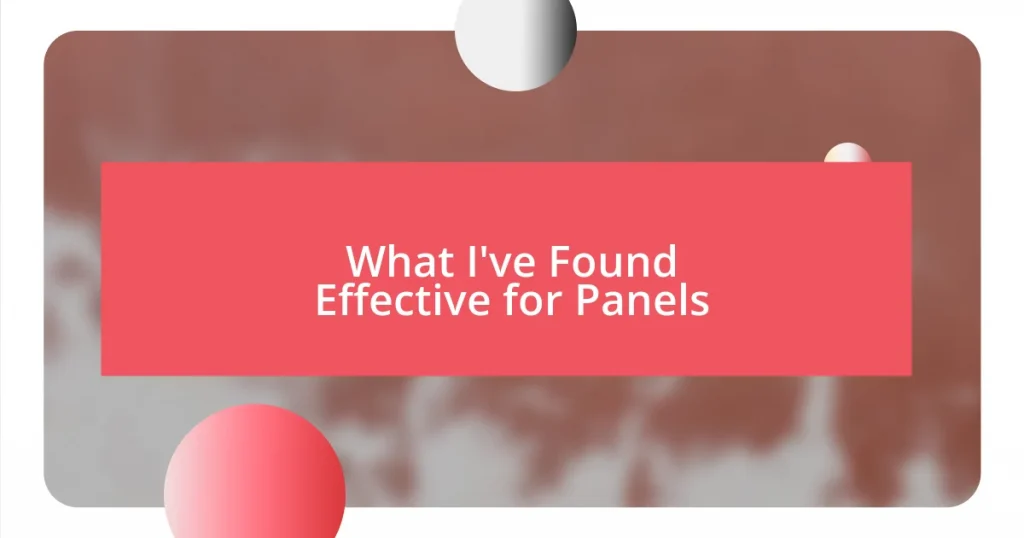Key takeaways:
- Understanding panel dynamics involves recognizing both verbal and non-verbal cues, and fostering collaboration by setting common goals among panelists.
- Craft engaging topics that inspire curiosity and connection; prioritize open-ended questions and encourage personal storytelling for deeper discussions.
- Evaluate panel success through audience engagement, feedback collection, and observing panelists’ and audience’s body language, ensuring an impactful experience continues beyond the event.

Understanding Panel Dynamics
Panel dynamics can be fascinating, as they operate like a living organism, influenced by the personalities, experiences, and motivations of each member. I remember sitting in a panel discussion where the energy shifted dramatically when one member, who was notoriously quiet, suddenly shared an unexpected personal story. That moment changed the entire atmosphere—everyone leaned in, and a deeper, more authentic conversation blossomed.
Navigating the varied interactions within a panel requires keen observation of both verbal and non-verbal cues. I often ask myself, “How can I adapt my approach to draw out quieter members while keeping the more vocal ones engaged?” It’s this balancing act that makes each panel unique and, frankly, a bit unpredictable. Sometimes, the most profound insights come from the most unlikely sources, transforming the discussion into a richer experience.
Furthermore, understanding the motivations behind why panelists participate can significantly affect the dynamics. For instance, I once had a colleague join a panel solely to share their groundbreaking research, which, honestly, left little room for collaboration. Reflecting on that experience, I realized the importance of setting a common goal ahead of time. What if we aimed for synergy rather than individual accolades? It’s a perspective shift that could enhance not just participation but the richness of the dialogue itself.

Creating Engaging Panel Topics
Crafting topics that genuinely resonate can be the backbone of a successful panel. I’ve experienced firsthand how an intriguing title can create anticipation, inviting both panelists and the audience to engage deeply. For example, a session I once attended titled “Beyond the Buzz: Real Impact in Social Media” sparked lively discussions because it transcended surface-level trends to address substantial outcomes. Choosing themes that challenge norms or encourage storytelling often leads to memorable exchanges.
When brainstorming engaging panel topics, consider these approaches:
- Focus on current trends or pressing issues that prompt passionate debates.
- Encourage personal stories that provide unique perspectives on shared experiences.
- Create opportunities for problem-solving or collaborative discussions, rather than merely sharing expert opinions.
- Use provocative questions as topics to ignite curiosity and invite diverse viewpoints.
- Curate themes that leverage the diversity of the panelists, allowing their varied backgrounds to enrich the conversation.
Reflecting on this, I’ve realized that the most stimulating discussions arise from topics that aren’t just informative but inspire curiosity, empathy, and collaboration among participants. It’s a deliberate choice that transforms a simple discussion into a rich dialogue.

Selecting the Right Panelists
Selecting the right panelists can truly make or break the entire discussion. I remember a panel I attended where the mix of expertise was perfect. Each panelist brought a different perspective on the topic, which allowed for a robust discussion. It felt like each voice added a unique thread to a rich tapestry of insights. But sometimes, I’ve seen the opposite happen—panelists who didn’t mesh well together, leading to a disconnect that left the audience disengaged.
It’s crucial to consider not just the knowledge of the panelists, but their styles and personalities, too. During one event, we had an incredibly knowledgeable expert who was also incredibly monotone. While their facts were sound, the delivery lacked enthusiasm, making it hard for the room to stay engaged. I’ve observed that a diverse range of personalities often enhances the conversation; having both the quieter thinkers and the more outspoken folks can create a dynamic environment.
Lastly, aligning panelists’ motivations can significantly enhance the overall experience. I’ve found that when panelists are genuinely eager to share and connect, the atmosphere transforms. In one panel I organized, I noticed that when everyone was passionate about the shared subject matter, the discussions flowed naturally. A sense of camaraderie developed among the panelists, making it feel like a conversation among friends rather than a formal presentation. This kind of synergy not only captivates the audience but also fosters deeper insights that transcend individual expertise.
| Criteria | Importance |
|---|---|
| Diversity of Backgrounds | Encourages richer discussions |
| Personality Fit | Affects engagement and energy |
| Shared Motive | Facilitates genuine interaction |

Crafting Thoughtful Panel Questions
When I think about crafting thoughtful panel questions, I recall a workshop I attended where the questions were intriguingly open-ended. This design encouraged panelists to share their personal experiences, leading to a richer interaction with the audience. Have you ever participated in a discussion that felt alive because the questions allowed for honest storytelling? It really highlighted for me the importance of asking questions that evoke emotion and provoke thoughtful reflection.
An effective question should invite panelists to explore not just their expertise but how their life experiences intertwine with the topic. For instance, instead of asking, “What are the trends in digital marketing?”, I’ve found it’s far more engaging to ask, “How has your understanding of digital marketing changed due to a pivotal moment in your career?” This not only opens the floor for captivating narratives but creates a connection with the audience, who can relate to personal stories and moments of change.
Additionally, I always strive to include a question that challenges conventional wisdom. I remember a panel where I posed the question, “What’s one widely accepted rule in your field that you believe should be broken?” The room buzzed with excitement, and I could see panelists lighting up as they offered their counter-narratives. It’s these kinds of questions—those that push boundaries and invite debate—that truly elevate a panel discussion from being mere information sharing to a dynamic conversation that leaves everyone inspired.

Promoting Audience Interaction
One of the most effective strategies I’ve encountered for promoting audience interaction is integrating real-time polls or questions. In one event, we used a simple text-to-vote tool that allowed participants to voice their opinions instantly. The energy in the room shifted as attendees realized their input mattered. I still remember the buzz of excitement as people eagerly participated. It transformed the panel from a monologue into a dialogue, where everyone felt like they had a stake in the discussion.
Encouraging questions from the audience can also be a game-changer. During a recent panel, I made it a point to pause after every couple of topics and invited the audience to chime in. I could feel the shift; several attendees who initially appeared shy began to engage, sharing their thoughts and asking insightful questions. It created an enriching atmosphere, and I could sense the panelists relishing the dynamic interchange. It’s incredible how a simple invitation can amplify involvement and foster a deeper connection between the panelists and the audience.
I often reflect on the impact of storytelling in audience interaction. At one memorable conference, I suggested to the panelists that they share a personal failure related to the topic. What ensued was a candid exchange of vulnerabilities that resonated deeply with the audience. People started nodding, and I even saw a few wiping away tears. Isn’t it fascinating how sharing our struggles can unite us? It reminded me that authentic interaction often stems from our shared humanity, which can spark conversations that linger long after the event.

Managing Time Effectively
Sometimes, I find that effective time management during panels isn’t just about sticking to a schedule but also about remaining flexible. I once attended a discussion where, despite a planned agenda, the panelists got caught up in a particularly engaging topic. Instead of rushing through the remaining questions, the moderator decided to flow with the conversation. It created a sense of spontaneity that invigorated the audience. Have you ever noticed how the best moments in discussions often stem from a departure from the script?
I also believe that setting clear time limits for each segment is crucial. At my last panel, we used a visible timer for each question. This visual cue not only helped the panelists adjust their responses but kept the energy high and the conversation engaging. It’s amazing how accountability can motivate everyone to be concise. Does it surprise you how much more focused discussions become when there’s a respectful limit on speaking time?
One practical tip I’ve implemented is the use of a pre-panel rehearsal. I was part of a session where we practiced timing during our run-through. This preparation allowed us to identify certain areas that might need more time and made the actual panel run incredibly smoothly. Seeing the panelists gain confidence was a highlight for me. It reinforced the idea that managing time effectively doesn’t just enhance the experience but also fosters a sense of teamwork and collaboration. Isn’t it comforting to know that a little practice can lead to a significant improvement in how we engage with our audience?

Evaluating Panel Success
Evaluating the success of a panel often involves measuring audience engagement and the quality of interactions that emerge. I recall an intriguing panel where we handed out feedback forms immediately after the session. The insights gathered were eye-opening; attendees expressed how they appreciated the depth of discussion and the diversity of perspectives presented. Have you ever seen how much audience feedback can reveal about a panel’s impact? It truly informs adjustments to future events.
Another effective gauge I’ve found is observing the body language of both the panelists and the audience. During one particular discussion, I noticed the panelists leaning in, actively engaging with the audience, and often making eye contact. The vibe was electric! You could feel the room come alive, with heads nodding and laughter filling the air. Isn’t it exciting when you see clear signs that everyone is genuinely connected? Those moments indicate not just a successful panel but a meaningful exchange of ideas.
Lastly, assessing post-event follow-up can be revealing. After one panel, we created a community space for continued discussion online. The questions and topics that emerged kept the momentum alive well after the event concluded. I was pleasantly surprised by the ongoing conversations that unfolded; they provided us with invaluable insights into what resonated most. How often do we consider the longevity of a panel’s impact? It can be quite transformative, extending the life of the discussion beyond the physical venue!












